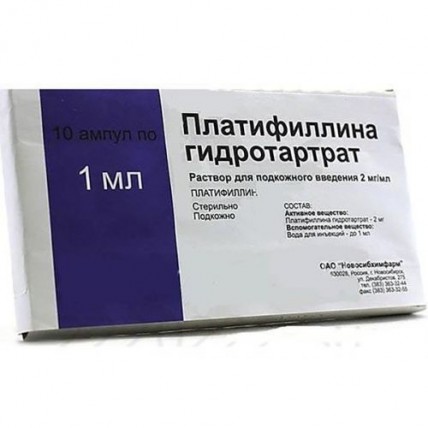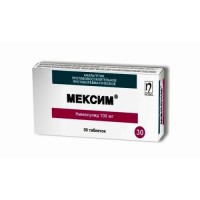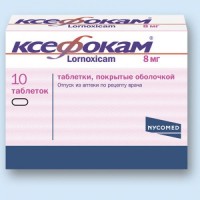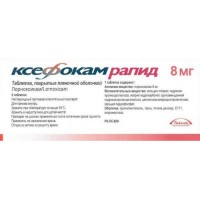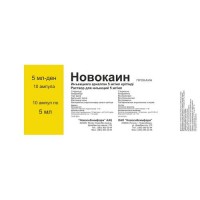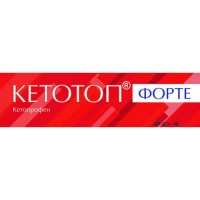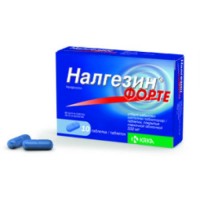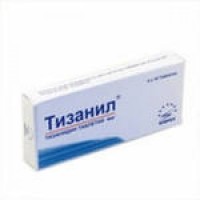Platifillina tartrate 2 mg / ml solution 10s n / to the introduction in ampules
- $7.00
The instruction
for medical use
of medicine
of Platyphyllinum hydrotartrate
the Trade name
of Platyphyllinum hydrotartrate
the International unlicensed name
Is not present
the Dosage form
Solution for hypodermic introduction of 2 mg/ml, 1 ml
Structure
of 1 ml of drug contains
active agent – Platyphyllinum hydrotartrate - 2.0 mg
excipients: water for injections up to 1.0 ml
the Description
Transparent colourless liquid.
Pharmacotherapeutic group
Drugs for treatment of functional disorders of intestines. Synthetic holinoblokator - ethers with a tertiary amino group.
The ATX A03AA code
passes the Pharmacological Pharmacokinetics Easily properties through gistogematichesky barriers (including a gematoentsefalitichesky barrier), cellular and synaptic membranes.
At introduction of high doses collects in the central nervous system in significant concentration. It is metabolized in a liver. Is exposed to hydrolysis with formation of a platinetsin and platinetsinovy acid. It is removed by kidneys and intestines. Does not kumulirut.
Pharmacodynamics
M-holinoblokator, in comparison with atropine has less impact on peripheral m-holinoretseptory (on action on smooth muscle cells of bodies of the digestive tract (DT) and a circular muscle of an iris is 5-10 times weaker than atropine). Blocking m-holinoretseptory, breaks transfer of nervous impulses from postganglionic cholinergic nerves on the effector bodies and fabrics (heart, smooth muscle bodies, glands of external secretion) innervated by them, suppresses also N-holinoretseptory (much more weakly).
Holinoblokiruyushchy action is more shown against the background of the raised tone of a parasympathetic part of the autonomic nervous system or action of m-holinostimulyatorov. To a lesser extent, than atropine, causes tachycardia, especially at use in high doses. Reducing influence of n.vagus, improves conductivity of heart, increases excitability of a myocardium, increases the minute volume of blood.
Has direct myotropic spasmolytic effect, causes expansion of small vessels of skin. In high doses the vasomotor center oppresses and blocks sympathetic a ganglion owing to what vessels extend and arterial blood pressure (decreases mainly at intravenous administration).
More weakly than atropine oppresses secretion of hemadens, causes the significant decrease in a tone of unstriated muscles, amplitudes and frequencies of peristaltic reductions of a stomach, a duodenum, a small and large intestine, moderate decrease in a tone of a gall bladder (at persons with a hyperkinesia of biliary tract), in a hypokinesia – a tone of a gall bladder increases before normal contents.
Causes relaxation of smooth muscles of a uterus, bladder and urinary tract, having spasmolytic effect, eliminates a pain syndrome. Relaxes the smooth muscles of bronchial tubes caused by increase in a tone of n.vagus or holinostimulyator, increases the minute volume of breath, oppresses secretion of bronchial glands, reduces a tone of sphincters.
Excites a brain and a respiratory center, more - a spinal cord (in high doses spasms, oppression of the central nervous system (CNS), the vasomotor and respiratory centers are possible).
Gets through a gematoentsefalitichesky barrier.
Indications
- a peptic ulcer of a stomach and duodenum (as a part of combination therapy)
- a pylorospasm
- cholecystitis
- a cholelithiasis
- intestinal, renal and bilious gripes
the Route of administration and doses
In a peptic ulcer of a stomach and duodenum, for stopping of attacks of spastic pains (intestinal, hepatic, renal gripes) administer the drug under skin on 2-4 mg (1-2 ml of solution of 2 mg/ml). For course treatment (10-20 days) enter subcutaneously 2-4 mg 2-3 times a day.
The highest dose for adults: single – 10 mg, daily – 30 mg.
Side effects
- dryness of a mucous membrane of an oral cavity, thirst
- a lowering of arterial pressure
- tachycardia
- a mydriasis
- accommodation paralysis
- an intestines atony
- dizziness, a headache
- photophobia
- spasms,
- an ischuria
- acute psychosis (in high doses)
- an atelectasis of an easy
Contraindication
- the increased individual sensitivity
- pregnancy and the period of a lactation
- closed-angle glaucoma
- a cachexia
- the profound atherosclerosis
- heart failure of the II-III degree, arrhythmia, tachycardia
- a prostate hyperplasia
- a liver and/or renal failure
- a piloroduodenalny stenosis
- phrenic hernia in combination with a reflux esophagitis
- paralytic Ilheus
- an intestines atony
- bleeding from bodies of digestive tract
- the megacolon complicated by ulcer colitis
- advanced and senile age.
- the children's age up to 15 years
Medicinal interactions
Strengthens sedative and somnolent effect of phenobarbital, pentobarbital, sulfate magnesium.
Other m-holinoblokatory, amantadin, a haloperidol, fenotiazin, monoamine oxidase inhibitors, tricyclic antidepressants, some antihistaminic drugs increase risk of development of side effects.
Antagonism with cholinesterase inhibitors.
Morphine strengthens the oppressing action on a cardiovascular system, monoamine oxidase inhibitors - positive hrono- and bathmotropic effects, cardiac glycosides - positive bathmotropic action, quinidine, procaineamide – m-holinoblokiruyushchee action.
In the pains connected with spasms of smooth muscles, action is strengthened by analgetics, sedatives, tranquilizers, at vascular spasms - hypotensive and sedatives.
Special instructions
With care apply in diseases of a cardiovascular system in which increase in heart rate is undesirable (acute bleeding, an atrial fibrillation, tachycardia, etc.), at the increased body temperature (its further increase owing to suppression of activity of sweat glands is possible), an achalasia of a gullet and a pyloric stenosis (the possible decrease in motility and a tone resulting in impassability to a stomach contents delay) of an intestines atony at patients of advanced age or the weakened patients, a closed-angle and open angle glaucoma, toxicosis, pregnant women, injury of a brain at children
the Reflux esophagitis, the hernia of an esophageal opening of a diaphragm which is combined about a reflux esophagitis (decrease in motility of a gullet and stomach and relaxation of the lower esophageal sphincter can promote delay of gastric emptying and strengthening of a gastroesophageal reflux through a sphincter with the broken function).
Digestive tract diseases which are followed by impassability: an achalasia and a pyloric stenosis (the decrease in motility and a tone resulting in impassability and a delay of contents of a stomach is possible).
An intestines atony at patients of advanced age or the weakened patients (development of impassability is possible), paralytic intestinal impassability.
Diseases with the increased intraocular pressure: closed-angle glaucoma (the mydriatic effect leading to increase in intraocular pressure can cause a bad attack), an open angle glaucoma (the mydriatic effect can cause some increase in intraocular pressure, therapy correction can be required), age is more senior than 40 years (danger of manifestation of not diagnosed glaucoma).
Nonspecific ulcer colitis (high doses can oppress an intestines vermicular movement, increasing the probability of paralytic impassability of intestines, besides, manifestation or aggravation of such complication as toxic megacolon is possible).
Dryness of a mucous membrane of an oral cavity (prolonged use can cause further strengthening of expressiveness of xerostomia).
A liver failure (decrease in metabolism) and a renal failure (risk of development of side effects owing to decrease in removal).
Chronic diseases of lungs, especially at children of younger age and the weakened patients (reduction of bronchial secretion can lead to condensation of a secret and formation of traffic jams in bronchial tubes).
A myasthenia (the state can worsen because of acetylcholine inhibition).
A vegetative (autonomous) neuropathy (the ischuria and paralysis of accommodation can amplify), a prostate hyperplasia without obstruction of urinary tract, an ischuria or predisposition to it or diseases which are followed by obstruction of urinary tract (including bladder necks owing to a prostate hyperplasia).
A gestosis (strengthening of arterial hypertension is possible).
Injuries of a brain at children (effects from the central nervous system can amplify).
Down syndrome (perhaps unusual expansion of pupils and increase in heart rate).
The central paralysis at children (reaction to holinoblokator can be most significant).
During treatment it is necessary to exercise regular control of arterial blood pressure and pulse.
During treatment it is necessary to avoid consumption of alcoholic beverages.
The feature of influence of medicine on ability to run vehicles or potentially dangerous mechanisms
needs to abstain from control of vehicles and occupations other potentially dangerous types of activity demanding the increased concentration of attention and speed of psychomotor reactions.
Overdose
Symptoms: paralytic intestinal impassability, a sharp ischuria (at patients with prostate adenoma), accommodation paralysis, increase in intraocular pressure, dryness of a mucous membrane of an oral cavity, nose, throat, difficulty of swallowing, the speech, a mydriasis (before total disappearance of an iris), a tremor, spasms, a hyperthermia, excitement, oppression of the central nervous system, suppression of activity of the respiratory and vasomotor centers.
Treatment: artificial diuresis, parenteral administration of m cholinomimetics and inhibitors of cholinesterase. At a hyperthermia - damp rubdowns, febrifuges, at excitement - intravenous administration of thiopental of sodium, at a mydriasis - locally, in the form of eye drops pilocarpine. In case of development of an attack of glaucoma immediately in a conjunctival sac dig in 1% pilocarpine solution in each hour on 2 drops and subcutaneously - 1 ml of 0.05% of solution of Prozerin (neostigmina of methyl sulfate) 3-4 times a day.
A form of release and packing
Solution for hypodermic introduction of 2 mg/ml. On 1 ml in ampoules of neutral glass.
On 10 ampoules with the instruction for medical use in the state and Russian languages and a knife for opening of ampoules or the scarificator ampoule place in a box of cardboard.
On 5 or 10 ampoules place in blister strip packaging from a film polyvinylchloride or tapes of polietilentereftalatny and aluminum foil or paper with a polyethylene covering either without foil, or without paper.
On 1ili 2 planimetric packs (on 5 or 10 ampoules) together with the instruction for medical use in the state and Russian languages and a knife for opening of ampoules or the scarificator ampoule place in a pack from cardboard.
When packing ampoules with a ring of a break or a point of a break the knife for opening of ampoules or the scarificator ampoule is not put.
To Store storage conditions at a temperature from 10 to 25 of 0C.
To store out of children's reach.
Period of storage
of 5 years. Not to use after expiry date.
Prescription status
According to the prescription
JSC Novosibkhimfarm Producer 630028, Russia, Novosibirsk, Dekabristov St., 275
ph. (383) 363-32-44, fax (383) 363-32-55
Owner of the registration certificate:
JSC Novosibkhimfarm
630028, Russia, Novosibirsk, Dekabristov St., 275
ph. (383) 363-32-44, fax (383) 363-32-55
The address of the organization accepting claims for territories of the Republic of Kazakhstan from consumers on quality of products (goods) Representative office of JSC Valenta Pharm in RK, Almaty, the ave. of Abay, ug. Radostovts St., 151/115, business center "Ala Tau" office No. 702 of Ph./ fax 8727 334-15-52, E-mail:
To Develop asia@valentapharm.com
for medical use
of medicine
of Platyphyllinum hydrotartrate
the Trade name
of Platyphyllinum hydrotartrate
the International unlicensed name
Is not present
the Dosage form
Solution for hypodermic introduction of 2 mg/ml, 1 ml
Structure
of 1 ml of drug contains
active agent – Platyphyllinum hydrotartrate - 2.0 mg
excipients: water for injections up to 1.0 ml
the Description
Transparent colourless liquid.
Pharmacotherapeutic group
Drugs for treatment of functional disorders of intestines. Synthetic holinoblokator - ethers with a tertiary amino group.
The ATX A03AA code
passes the Pharmacological Pharmacokinetics Easily properties through gistogematichesky barriers (including a gematoentsefalitichesky barrier), cellular and synaptic membranes.
At introduction of high doses collects in the central nervous system in significant concentration. It is metabolized in a liver. Is exposed to hydrolysis with formation of a platinetsin and platinetsinovy acid. It is removed by kidneys and intestines. Does not kumulirut.
Pharmacodynamics
M-holinoblokator, in comparison with atropine has less impact on peripheral m-holinoretseptory (on action on smooth muscle cells of bodies of the digestive tract (DT) and a circular muscle of an iris is 5-10 times weaker than atropine). Blocking m-holinoretseptory, breaks transfer of nervous impulses from postganglionic cholinergic nerves on the effector bodies and fabrics (heart, smooth muscle bodies, glands of external secretion) innervated by them, suppresses also N-holinoretseptory (much more weakly).
Holinoblokiruyushchy action is more shown against the background of the raised tone of a parasympathetic part of the autonomic nervous system or action of m-holinostimulyatorov. To a lesser extent, than atropine, causes tachycardia, especially at use in high doses. Reducing influence of n.vagus, improves conductivity of heart, increases excitability of a myocardium, increases the minute volume of blood.
Has direct myotropic spasmolytic effect, causes expansion of small vessels of skin. In high doses the vasomotor center oppresses and blocks sympathetic a ganglion owing to what vessels extend and arterial blood pressure (decreases mainly at intravenous administration).
More weakly than atropine oppresses secretion of hemadens, causes the significant decrease in a tone of unstriated muscles, amplitudes and frequencies of peristaltic reductions of a stomach, a duodenum, a small and large intestine, moderate decrease in a tone of a gall bladder (at persons with a hyperkinesia of biliary tract), in a hypokinesia – a tone of a gall bladder increases before normal contents.
Causes relaxation of smooth muscles of a uterus, bladder and urinary tract, having spasmolytic effect, eliminates a pain syndrome. Relaxes the smooth muscles of bronchial tubes caused by increase in a tone of n.vagus or holinostimulyator, increases the minute volume of breath, oppresses secretion of bronchial glands, reduces a tone of sphincters.
Excites a brain and a respiratory center, more - a spinal cord (in high doses spasms, oppression of the central nervous system (CNS), the vasomotor and respiratory centers are possible).
Gets through a gematoentsefalitichesky barrier.
Indications
- a peptic ulcer of a stomach and duodenum (as a part of combination therapy)
- a pylorospasm
- cholecystitis
- a cholelithiasis
- intestinal, renal and bilious gripes
the Route of administration and doses
In a peptic ulcer of a stomach and duodenum, for stopping of attacks of spastic pains (intestinal, hepatic, renal gripes) administer the drug under skin on 2-4 mg (1-2 ml of solution of 2 mg/ml). For course treatment (10-20 days) enter subcutaneously 2-4 mg 2-3 times a day.
The highest dose for adults: single – 10 mg, daily – 30 mg.
Side effects
- dryness of a mucous membrane of an oral cavity, thirst
- a lowering of arterial pressure
- tachycardia
- a mydriasis
- accommodation paralysis
- an intestines atony
- dizziness, a headache
- photophobia
- spasms,
- an ischuria
- acute psychosis (in high doses)
- an atelectasis of an easy
Contraindication
- the increased individual sensitivity
- pregnancy and the period of a lactation
- closed-angle glaucoma
- a cachexia
- the profound atherosclerosis
- heart failure of the II-III degree, arrhythmia, tachycardia
- a prostate hyperplasia
- a liver and/or renal failure
- a piloroduodenalny stenosis
- phrenic hernia in combination with a reflux esophagitis
- paralytic Ilheus
- an intestines atony
- bleeding from bodies of digestive tract
- the megacolon complicated by ulcer colitis
- advanced and senile age.
- the children's age up to 15 years
Medicinal interactions
Strengthens sedative and somnolent effect of phenobarbital, pentobarbital, sulfate magnesium.
Other m-holinoblokatory, amantadin, a haloperidol, fenotiazin, monoamine oxidase inhibitors, tricyclic antidepressants, some antihistaminic drugs increase risk of development of side effects.
Antagonism with cholinesterase inhibitors.
Morphine strengthens the oppressing action on a cardiovascular system, monoamine oxidase inhibitors - positive hrono- and bathmotropic effects, cardiac glycosides - positive bathmotropic action, quinidine, procaineamide – m-holinoblokiruyushchee action.
In the pains connected with spasms of smooth muscles, action is strengthened by analgetics, sedatives, tranquilizers, at vascular spasms - hypotensive and sedatives.
Special instructions
With care apply in diseases of a cardiovascular system in which increase in heart rate is undesirable (acute bleeding, an atrial fibrillation, tachycardia, etc.), at the increased body temperature (its further increase owing to suppression of activity of sweat glands is possible), an achalasia of a gullet and a pyloric stenosis (the possible decrease in motility and a tone resulting in impassability to a stomach contents delay) of an intestines atony at patients of advanced age or the weakened patients, a closed-angle and open angle glaucoma, toxicosis, pregnant women, injury of a brain at children
the Reflux esophagitis, the hernia of an esophageal opening of a diaphragm which is combined about a reflux esophagitis (decrease in motility of a gullet and stomach and relaxation of the lower esophageal sphincter can promote delay of gastric emptying and strengthening of a gastroesophageal reflux through a sphincter with the broken function).
Digestive tract diseases which are followed by impassability: an achalasia and a pyloric stenosis (the decrease in motility and a tone resulting in impassability and a delay of contents of a stomach is possible).
An intestines atony at patients of advanced age or the weakened patients (development of impassability is possible), paralytic intestinal impassability.
Diseases with the increased intraocular pressure: closed-angle glaucoma (the mydriatic effect leading to increase in intraocular pressure can cause a bad attack), an open angle glaucoma (the mydriatic effect can cause some increase in intraocular pressure, therapy correction can be required), age is more senior than 40 years (danger of manifestation of not diagnosed glaucoma).
Nonspecific ulcer colitis (high doses can oppress an intestines vermicular movement, increasing the probability of paralytic impassability of intestines, besides, manifestation or aggravation of such complication as toxic megacolon is possible).
Dryness of a mucous membrane of an oral cavity (prolonged use can cause further strengthening of expressiveness of xerostomia).
A liver failure (decrease in metabolism) and a renal failure (risk of development of side effects owing to decrease in removal).
Chronic diseases of lungs, especially at children of younger age and the weakened patients (reduction of bronchial secretion can lead to condensation of a secret and formation of traffic jams in bronchial tubes).
A myasthenia (the state can worsen because of acetylcholine inhibition).
A vegetative (autonomous) neuropathy (the ischuria and paralysis of accommodation can amplify), a prostate hyperplasia without obstruction of urinary tract, an ischuria or predisposition to it or diseases which are followed by obstruction of urinary tract (including bladder necks owing to a prostate hyperplasia).
A gestosis (strengthening of arterial hypertension is possible).
Injuries of a brain at children (effects from the central nervous system can amplify).
Down syndrome (perhaps unusual expansion of pupils and increase in heart rate).
The central paralysis at children (reaction to holinoblokator can be most significant).
During treatment it is necessary to exercise regular control of arterial blood pressure and pulse.
During treatment it is necessary to avoid consumption of alcoholic beverages.
The feature of influence of medicine on ability to run vehicles or potentially dangerous mechanisms
needs to abstain from control of vehicles and occupations other potentially dangerous types of activity demanding the increased concentration of attention and speed of psychomotor reactions.
Overdose
Symptoms: paralytic intestinal impassability, a sharp ischuria (at patients with prostate adenoma), accommodation paralysis, increase in intraocular pressure, dryness of a mucous membrane of an oral cavity, nose, throat, difficulty of swallowing, the speech, a mydriasis (before total disappearance of an iris), a tremor, spasms, a hyperthermia, excitement, oppression of the central nervous system, suppression of activity of the respiratory and vasomotor centers.
Treatment: artificial diuresis, parenteral administration of m cholinomimetics and inhibitors of cholinesterase. At a hyperthermia - damp rubdowns, febrifuges, at excitement - intravenous administration of thiopental of sodium, at a mydriasis - locally, in the form of eye drops pilocarpine. In case of development of an attack of glaucoma immediately in a conjunctival sac dig in 1% pilocarpine solution in each hour on 2 drops and subcutaneously - 1 ml of 0.05% of solution of Prozerin (neostigmina of methyl sulfate) 3-4 times a day.
A form of release and packing
Solution for hypodermic introduction of 2 mg/ml. On 1 ml in ampoules of neutral glass.
On 10 ampoules with the instruction for medical use in the state and Russian languages and a knife for opening of ampoules or the scarificator ampoule place in a box of cardboard.
On 5 or 10 ampoules place in blister strip packaging from a film polyvinylchloride or tapes of polietilentereftalatny and aluminum foil or paper with a polyethylene covering either without foil, or without paper.
On 1ili 2 planimetric packs (on 5 or 10 ampoules) together with the instruction for medical use in the state and Russian languages and a knife for opening of ampoules or the scarificator ampoule place in a pack from cardboard.
When packing ampoules with a ring of a break or a point of a break the knife for opening of ampoules or the scarificator ampoule is not put.
To Store storage conditions at a temperature from 10 to 25 of 0C.
To store out of children's reach.
Period of storage
of 5 years. Not to use after expiry date.
Prescription status
According to the prescription
JSC Novosibkhimfarm Producer 630028, Russia, Novosibirsk, Dekabristov St., 275
ph. (383) 363-32-44, fax (383) 363-32-55
Owner of the registration certificate:
JSC Novosibkhimfarm
630028, Russia, Novosibirsk, Dekabristov St., 275
ph. (383) 363-32-44, fax (383) 363-32-55
The address of the organization accepting claims for territories of the Republic of Kazakhstan from consumers on quality of products (goods) Representative office of JSC Valenta Pharm in RK, Almaty, the ave. of Abay, ug. Radostovts St., 151/115, business center "Ala Tau" office No. 702 of Ph./ fax 8727 334-15-52, E-mail:
To Develop asia@valentapharm.com
